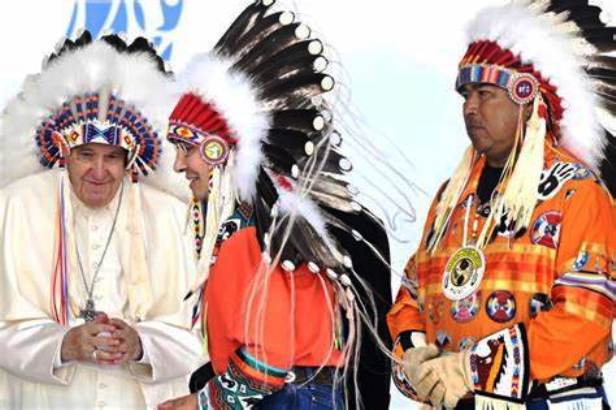All we hear is the negative stuff; nobody’s interested in the positive, the joy in that school. Nine of the happiest years of my life I spent…at that school. I learned your language, for God’s sake. Have you learned my language? No, so who’s the privileged one and who is underprivileged? …You may have heard stories from 7,000 witnesses in the process that were negative. But what you haven’t heard are the 7,000 reports that were positive stories. There are many very successful people today that went to those schools and have brilliant careers and are very functional people, very happy people like myself. I have a thriving international career, and it wouldn’t have happened without that school. (Cree author, playwright and musician Tomson Highway)
It’s been a month since Pope Francis made his six-day visit to Canada billed as a ‘Pilgrimage of Penance’ that he said he hoped would help heal the wrongs done to Indigenous people in Canada by the Roman Catholic Church.
Perhaps this is time enough to assess its early legacy — a legacy that so far has not brought the peace and harmony hoped for since May 27, 2021 when the Tk’emlúps te Secwépemc Kukpi7 issued a statement claiming the unmarked mass grave beside the Kamloops Indian Residential School held the remains of 215 children, some as young as three-years-old. At least, that was the claim for which evidence has yet to materialize.
Nor has the burning of dozens of Catholic churches across Canada ceased. Indeed, the burnings continue, the latest of which erupted in the early hours of August 25 when yet another historic Catholic Church – the Nativity of the Blessed Virgin Church at Fort Chipewyan in northern Alberta – was razed to its foundations, destroying with it more than a century of the recorded history of that hamlet, which most of the year is accessible only by plane.

Chief Allan Adam of the Athabasca Chipewyan First Nation (ACFN) reported that the church, built by Oblate missionaries in 1909, was completely destroyed: “Over 100 years in history, gone up in flames. This was uncalled for. This was a beautiful church.”
According to a national database, the church was built after a Roman Catholic mission was established there in 1849. The mission eventually included a residential school and the church that became home for over a century of history, including records of marriages, funerals and other significant moments in the community.
This was all part of the nation-building process ongoing across Canada during the 19th and 20th centuries when Canada prospered and came into its own as a strong, sane, prosperous and highly functional nation with its own culture which included all the disciplines — from science, engineering, literature and the arts to industry and the military which soon came to impress the wider world during World War I, World War II and Korea.
The RCMP is regarding the fire, which caused no injuries, as ‘suspicious’.
“Even though the relationship between Indigenous Peoples and the Roman Catholic Church is complicated, the loss of the church will be deeply felt in the community,” the AFCN council said in a statement.
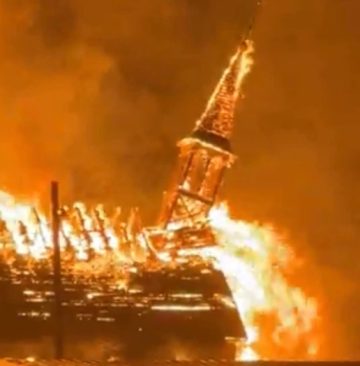
139 Residential Schools
For more than a century, various Catholic religious orders operated most of Canada’s 139 residential schools on behalf of the federal government. Roughly 150,000 children attended the schools which were chronically underfunded and later accused of sexual and physical abuse. During the 1920s, in amendments to the Indian Act, attendance was made compulsory and, due mainly to the high mortality rates from epidemic diseases such as tuberculosis, thousands of those children never returned home.
“It was very beautiful inside,” Blue-Eyes Simpson, a Roman Catholic Métis elder who grew up in the community” told CTV News Edmonton. “As a child and as a young teenager growing into my older years, even though it had closed its doors more regularly, we still could hear the elders singing in our Indigenous languages and those memories just resonated with us all the time.” And although the church no longer had a regular priest, she said, one would come in for funerals, weddings and baptisms.
But since the Kamloops report, community members had been concerned for the church because of the arsons at other Catholic churches, she said, adding that Fort Chipewyan is also considering bringing ground-penetrating radar to their community as part of a search of all the 139 residential school sites.
The Crime Scene
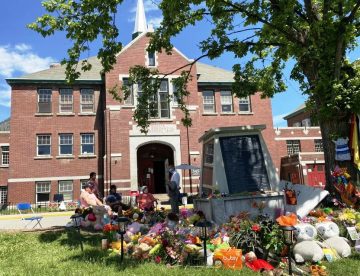 Which brings us straight back to last year`s triggering event in Kamloops which, for the past 16 months, has been shaming Canada with the unproven suggestion that the Indigenous Residential Schools system has been a maw of death, administered by Catholic priests, nuns and teachers whose vocation it was to provide warm beds, clean clothes, hot meals and a full education to Indigenous children living in remote locations across the country with little possibility of an education except for those schools.
Which brings us straight back to last year`s triggering event in Kamloops which, for the past 16 months, has been shaming Canada with the unproven suggestion that the Indigenous Residential Schools system has been a maw of death, administered by Catholic priests, nuns and teachers whose vocation it was to provide warm beds, clean clothes, hot meals and a full education to Indigenous children living in remote locations across the country with little possibility of an education except for those schools.
Yet on May 27, 2022, with dizzying speed, the routine care of Indigenous children in Christian residential schools was suddenly transformed into a crime scene. A crime scene based on the fact of their very existence.
For countless Indigenous children living in countless villages far-flung across the Great White North, the residential schools were built to provide them with a complete education, teaching them to read and write and informing them about the wider world and its long, complicated history. Without which, given the physical realities of the geography of their homes – often accessible only by plane – these children would have had almost no hope of a formal education. But this also meant that these youngsters would be away from home for months at a time. Just as Tomson Highway was.
Still, it is this fact of history through which issues related to Residential Schools should be viewed and assessed.
Instead, Canada and the world seem to have accepted unquestioningly a charge of genocide based on sketchy evidence of a radar photograph and a vague press release from an obscure website which was transmitted around the globe almost instantly and with the unspoken implication that cruel nuns had either killed hundreds of children or let them die and covered the whole thing up – all legitimized, or so it seemed, by The New York Times.
The Blame Game Begins
All this also provided a podium for Prime Minister Justin Trudeau who was just as quick to call the residential school system part of a larger colonial policy designed to eradicate Indigenous language and culture. All without a scintilla of hard evidence: “It is Canada’s fault that 215 Indigenous children were buried in an unmarked, mass grave at a one-time residential school in Kamloops, BC,” he pronounced on June 1.
Trudeau also demanded that Pope Francis visit Canada to make a formal apology for the Church`s role in whatever-this-was.
Canadians can’t close their eyes and pretend whatever-this-was didn’t happen, Trudeau scolded: “They must acknowledge that the country failed in its duty to those children, their families and their communities. They must also recognize the May 2(8) discovery of the children’s remains as part of a larger tragedy that saw thousands of Indigenous children torn from their families and sent to residential schools, where an untold number of them went `missing without a trace’.”
While he stopped short of calling it genocide, questions occur. Was Trudeau expecting Pope Francis to declare the Catholic Church’s role in the Residential School system “genocide”? And did he foresee any connection between the Kamloops affair and the 60-plus churches subsequently burned and vandalized? Or the statues of Sir John A. Macdonald and others being defaced and toppled across the country – prompting his former aide, Gerald Butts, to call the destruction “understandable”?
And did he foresee any connection between the Kamloops affair and the 60-plus churches subsequently burned and vandalized? Or the statues of Sir John A. Macdonald and others being defaced and toppled across the country – prompting his former aide, Gerald Butts, to call the destruction “understandable”?
Regardless, all seemed welcome fodder for Canada’s ‘woke’ media – subsidized by hundreds of millions of taxpayer dollars – and for globalist minions dedicated to smearing Canada’s colonial history and, increasingly, Canadian history itself. All of which now appears to fit neatly into the current national narrative as Canada – the world`s first ‘post-national state’ as Trudeau declared it to the New York Times after his election in 2015 – heads into a highly uncertain future now weighed down by a collapsing socialist health care system and a stream of degenerative and death-dealing legislation, a rapidly expanding euthanasia program, the escalating use of legalized marijuana, and the subjection of Canadians to ever more authoritarian legislation in general.
Pope Francis relents
In the end, Trudeau’s pressure paid off and the Pontiff agreed to visit Canada – a trip which occurred in late July and yielded two results. One was that the Catholic Church continues to be cast as an institutional abuser that robbed Indigenous children of their natural heritage by imposing the now-totally-unacceptable- tenets of the Catholic faith on helpless children ‘torn’ from their families and brainwashed in a ‘colonial’ faith now routinely despised by anti-Catholics everywhere with neither knowledge nor interest in the Catholic Church or its teachings. Or in the truth of its Founder, Jesus Christ, who instructed His apostles and their spiritual descendants to go forth into the world baptizing all nations in the Name of the Father, and the Son, and the Holy Spirit. And to do this for their eternal salvation for which He died on the Cross of Calvary and founded His Church, resulting in Christendom and all its spiritually civilizing power and order.
Tomson Highway
 This is a history Tomson Highway knows well. As the eleventh of twelve children in the Cree family of Joe and Pelagia Highway, Tomson was born on St. Nicholas Day in 1951. In his memoir Permanent Astonishment, he recounts growing up in a loving nomadic family in Nunavut where all were much blessed by his parents’ devout Catholicism, their daily rosary and by visits by the local priest to say Holy Mass. Tomson also took part in the family plans for each of the Highway children to attend ‘boarding school’ – a residential school – for a full education which, according to Highway, was much sought-after by Catholic parents and their large families who lived in the unimaginably vast north where isolation was routine and where, in most cases, small planes were the only way in and out of their villages which were without hospitals and where babies were born with the assistance of midwives. If available.
This is a history Tomson Highway knows well. As the eleventh of twelve children in the Cree family of Joe and Pelagia Highway, Tomson was born on St. Nicholas Day in 1951. In his memoir Permanent Astonishment, he recounts growing up in a loving nomadic family in Nunavut where all were much blessed by his parents’ devout Catholicism, their daily rosary and by visits by the local priest to say Holy Mass. Tomson also took part in the family plans for each of the Highway children to attend ‘boarding school’ – a residential school – for a full education which, according to Highway, was much sought-after by Catholic parents and their large families who lived in the unimaginably vast north where isolation was routine and where, in most cases, small planes were the only way in and out of their villages which were without hospitals and where babies were born with the assistance of midwives. If available.
As an author, playwright and musician, Highway counts his years at a residential school the greatest and happiest years of his life. It’s also where he made his first acquaintance with a piano, which led to his becoming a concert pianist – an impossible occurrence except for his school. But this is only part of why his memoir, a celebration of his 70th birthday, should be read by every Canadian who wishes to be further enlightened and enriched by Canada’s magnificent northern history. A history so deeply based in its landscape and its Christian roots that played such a central role in the lives of so many nomadic tribes across Canada, including the Six Nations, the Inuit, the Dene, the Métis, the Cree and so many others, and which included the blending of cultures and the writing of dictionaries in the various Indigenous languages.
For Highway, and the many tribes involved, theirs was an extraordinary life full of extraordinary experiences and extraordinary blessings. Theirs was also a uniquely Canadian way of life most post-Christian Canadians cannot comprehend. Just as St. Jean de Brebeuf and the other Canadian martyrs might have found today’s decadent culture incomprehensible as it continues conducting its subtle and ongoing campaign against Christianity in general and Catholicism in particular as it strives to take down Christendom block by block in its quest to replace it with a hoped-for secular happiness.
The Assault on Christianity
Nor is this contemporary godless era over. Yet it still can’t answer any of the questions burning in the hearts and souls of men, all made in the image and likeness of the Lord God Himself.
Nor can it stand up to any hard questioning. So perhaps it wasn’t surprising that when academics and journalists got around to examining the facts surrounding the so-called mass graves and asked sensible questions about the actual contents of those gravesites, those who’d made the startling claims in the first place were quiet. And rather than answering, there were concerted efforts to vilify anyone seeking a measure of scrutiny into these extraordinary claims.
For which no satisfactory answers have yet been released as such publications as The Dorchester Review (among others) continued to report the total absence of evidence. Even the New York Post weighed in on the press release`s first anniversary by debunking the original mass grave story as “fake news”.
“For the time being it seems the ‘smoke-screen’ that envelops so many Indigenous issues will prevent the sort of investigation that the alleged mass discovery of human remains would prompt if it occurred virtually anywhere other than a reservation,” reported Adam Soos for Rebel News. “This unwillingness to look at Indigenous issues in a critical light for fear of being deemed a bigot or denialist makes truth and reconciliation an impossibility as it blots out the truth from the get-go. This ‘smoke-screen’ is a major contributor not only to the inability to reconcile the wrongs of the past, but also to the ongoing struggles endured by Indigenous communities today, with simple issues like access to clean drinking water being muddied with politically correct talking points rather than unapologetic action.”
‘It was genocide’
Into all this came Pope Francis. “I have come to your native lands to tell you in person of my sorrow, to implore God’s forgiveness, healing and reconciliation, to express my closeness and to pray with you and for you,” he told his hosts in Maskwacis, Alberta, located about 70km south of Edmonton.
Francis’ apology builds on apologies from other religious institutions and from the federal government during the Harper years, along with an apology from Justin Trudeau last year built on earlier apologies for the forced relocation of Inuit communities in the Far North in 2019 when the PM apologized for “the federal government’s management of tuberculosis in the Arctic” from the ’40s to the ’60s.
Add to all that the confusion generated at the end of the Pontiff’s six-day visit and we arrive at its second result. This occurred on his return flight from Iqaluit to Rome when he pronounced the Indigenous Schools, staffed by many Catholic orders and by several Protestant missionary societies and funded by the Canadian government, as guilty of ‘genocide’, plain and simple.
“Yes, it is a genocide, yes, yes, clearly,” Pope Francis said.
The Oxford Dictionary defines ‘genocide’ as the deliberate extermination of a people or a nation.
Does that definition describe what happened – or didn’t happen – in this case? And if the inferred accusations of Kamloops are true, shouldn’t there be more than an apology?
And should that definition consign the hard work and life sacrifices of countless Catholic clergy and teachers –– who devoted their lives to assisting tens of thousands of Indigenous children in their growth to adulthood – to infamy? Were the selfless vocations of so many priests, nuns and teachers merely empty and graceless gestures for which no one should be thanking God? Including all the parents, such as the Highways, who regarded the schools as hugely beneficial to their children, so much so that it justified sending them away?
How are Canadians to respond?
So how are Canadians to respond to all this? What are they to make of these accusations? And the discrediting of blocks of their history for the crime of ‘cultural assimilation’ which occurs naturally and routinely across the world in all eras? What are they to make of the flags hung at half mast for months, children’s shoes grouped with candles into shrines and ribbons hung from railings at libraries as part of a nation-wide media-generated period of mourning? Amidst a total lack of hard evidence? Are they to hate themselves? And their country? And their history?
Regardless, what is true is that Canadians have been witnessing a demonstration of the immense political power of grievances and how they can be used – grievances easily found in any society in any era of human history and easily exploited for political and personal gain.
What is also true is that for the sixteen-plus months since the radar report, the media, politicians and opinion leaders are still ignoring the startling statistics of anti-Catholic hate crimes that have occurred since then – ten times higher than for all other hate crimes combined – and amidst an explosion of arson, vandalism, and threats to Catholic institutions as yet another church burns – this one in Fort Chipewyan – while media continue to downplay or even ignore it as of little consequence.
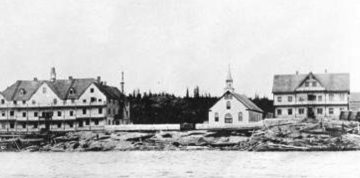
Remaking Canada
Nor, it appears, is Justin Trudeau finished with remaking Canada and its history. As evidenced just days ago when he unveiled a five-year, $100 million plan to support LGBTQ, two-spirit and intersex communities across the country. Dubbed “Canada’s first federal 2SLGBTQI+ Action Plan” during a press conference ahead of the pride parade in Ottawa, Trudeau called the plan the first federal initiative of its kind with a strategy that aims to reverse decades of ‘colonialism’ when thousands of LGBTQ personnel across the civil service, including Canadians in the military and RCMP, were grilled by special investigation units, hooked up to polygraph machines and ultimately discharged from service as a threat to national security.
So why are Canadians tolerating all this? Is it because they cannot see the true nature of what`s really going on? What`s underway is the “reseeding” of a whole New World Order, a political process which began four decades ago when political elites began a campaign of convincing the entire West that the dark and permanent stain of Western civilization has completely illegitimized the ’State’ itself whose redemption is now possible only through the continued “reseeding” of both its past (historical negation) and its future (population replacement) .
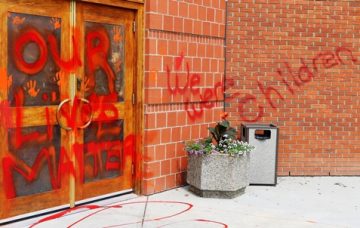
“This whole hideous process calls to mind the warning of Soviet defector, Yuri Bezmenov, who in 1984, laid out the four stages of psychological warfare by which the Kremlin had planned to triumph over the West,” writes Diana West in The Red Thread, her brilliant summation of the current political and ideological scene in Washington and across the West.
What’s the foundational first stage? Demoralization. And all that word implies. Which has been underway for decades.
So what could be more demoralizing to decent and orderly Canadians than the idea that Christian missionaries who sacrificed their lives to the education of Indigenous children across the North were actually sadistic perverts and killers?
Then comes Stage Two of Bezmenov’s formula – Destabilization – the signs of which are now ubiquitous and point to Canada’s eventual delivery into Stage Three – Crisis. With Canada now appearing to be going broke under a yoke of apparent government non-accountability – all denials notwithstanding – will any of the above measures reverse the economic deterioration flowing directly from the fallacious ideologies of the Trudeau government as it continues to take the axe to the foundations of Western civilization? Which, in turn, eventually delivers any targeted nation into the fourth stage – Normalization. Read: Totalitarian rule which quickly becomes deprivation and utter misery, the same misery Alexander Solzhenitsyn wrote and warned about.
Not a happy forecast, I know. But for anyone watching closely, worryingly accurate.
Pray for Canada.

